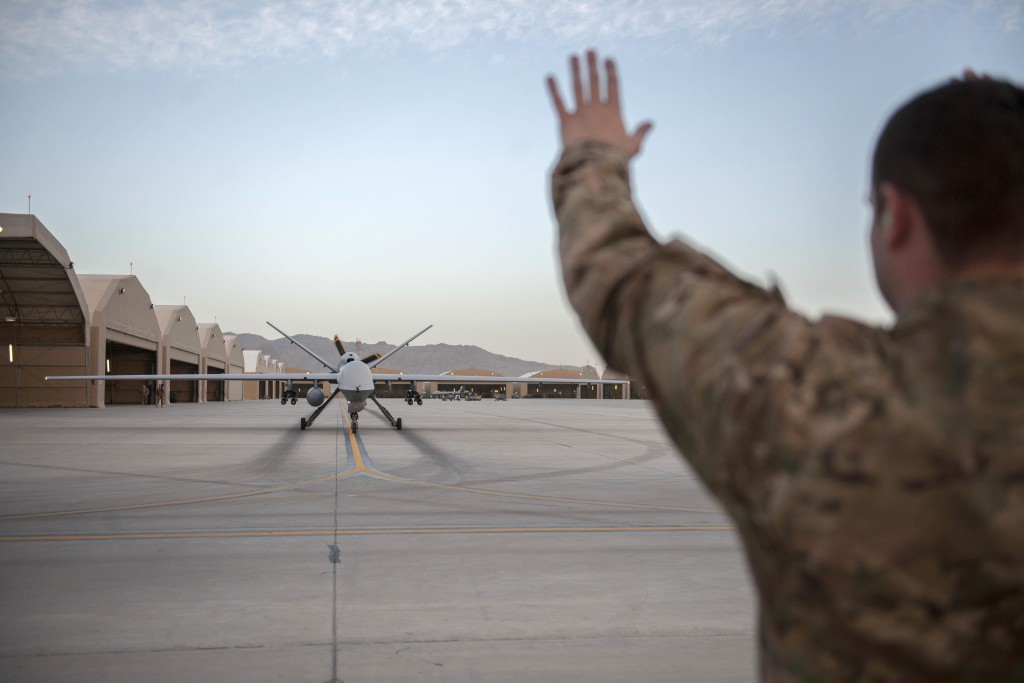
The 2016 Defence White Paper mentions ‘unmanned’ systems 15 times. The accompanying Integrated Investment Plan (IIP) [pdf] has 39 references. The government has clear ambitions to purchase UAVs for maritime surveillance and airborne strike, with unmanned systems for other roles evidently under consideration.
Starting with the most assured acquisition, the Triton maritime surveillance UAV has been under consideration for at least three years. The unarmed Triton will provide a high-altitude, high-endurance maritime surveillance capability in concert with the incoming (manned) P-8 Poseidon fleet and other assets. The RAAF is expected to acquire the Tritons from the early 2020s.
As has been flagged previously, the government will also seek to acquire a number of armed reconnaissance UAVs for the Army by the early 2020s. The IIP outlines a plan to acquire ‘armed intelligence, surveillance and reconnaissance unmanned aircraft’ between 2018 and 2038 in Table 8. Until now, Australia has only operated unarmed UAVs like the RQ-7B Shadow, although ADF personnel have been training on US Air Force MQ-9B Reaper armed UAVs for at least a year. A purchase of something like the Reaper is a likely outcome.
Things might get interesting in replacing the Tiger attack helicopter. The IIP states an aim to replace the Tiger with ‘manned or unmanned systems or a combination of both’ (6.32) during the 2020s. The newest generation of AH-64 Apache is likely to be a strong contender. Interestingly, the AH-64E is highly interoperable with the Shadow UAV, and can even take full control of the UAV. That’s a result of the US Armed Forces’ ongoing ‘MUM-T’ (manned-unmanned teaming) experiments, and the ADF is well-positioned to assimilate US experiences in this area.
An alternative or complement to a manned attack helicopter might be an armed vertical take-off UAV (VTUAV) like the MQ-8B Fire Scout, though it has about half the combat radius of an Apache. An unmanned Apache isn’t outside the realms of possibility (Boeing has an unmanned version of the Little Bird), although probably not in time for a Tiger replacement. The MQ-8C Fire Scout will be larger and have greater range than the MQ-8B model, and both can operate from the US Navy’s littoral combat ships (LCS).
The IIP also mentions a maritime tactical unmanned intelligence, surveillance and reconnaissance (ISR) capability (4.32). A Fire Scout or other VTUAV could be operated from RAN ships with helicopter pads. Whatever the chosen type, using a common platform across Army and Navy would streamline the logistics and support arrangements for the platform.
The ADF’s future unmanned systems needn’t be exclusively airborne. For example, the Fleet-class common unmanned surface vessel (USV), intended for the US Navy’s LCS, is designed for mine-hunting and anti-submarine warfare (ASW). A similar platform could be deployed from RAN’s surface combatants and even the future Offshore Patrol Vessel. The White Paper also announced a life extension for four of RAN’s Huon-class mine-hunters (4.36), and the IIP expressed Defence’s interest in a future, modular mine-hunting capability (4.38). A suitably-designed USV could provide rapid-deployable and upgradeable ASW, mine-hunting and ISR capabilities to the host ship.
Another unmanned platform considered in the IIP is a possible replacement of the F/A-18F Super Hornet in the 2030s with ‘either a fourth operational squadron of Joint Strike Fighters or possibly a yet to be developed unmanned combat aerial vehicle’ (5.11). The Joint Strike Fighter may itself be capable of controlling or remote-piloting multiple nearby UCAVs in the future. If so, a mixed manned-unmanned air capability might be an option for the RAAF. A long-range strike UCAV is also plausible, as demonstrated by the test flight of Britain’s Taranis UCAV at Woomera two years ago.
One unmanned capability is only fleetingly mentioned in the IIP: unmanned underwater vessels (UUVs). The future of submarine capability is highly likely to include launch and recovery of UUVs. Again, the US Navy is leading the way, with development of the Large Displacement UUV, designed to be deployable from Virginia- and Ohio-class submarines, and the REMUS 600 Autonomous Underwater Vehicle (AUV), which was launched from a Virginia-class submarine last year.
However, there’s no mention in the DWP or IIP of any unmanned land systems or robots. Military robots tend to be limited to tasks like bomb disposal, like the ADF’s Talon RPV. The US has also tested remote-operated gun towers and walking robots, though it’s not yet clear where unmanned land systems will fit into the future of the ADF.
Unmanned systems are proliferating throughout Australia’s region and the globe, although they vary greatly in technological capability. A relatively small but high-tech military like the ADF can’t afford to overlook the potential of unmanned systems to be significant force multipliers, allowing us to leverage our technological advantages over potential adversaries. In any case, the 2016 Defence White Paper and IIP indicate a trend toward a growing role for unmanned systems for the ADF.

